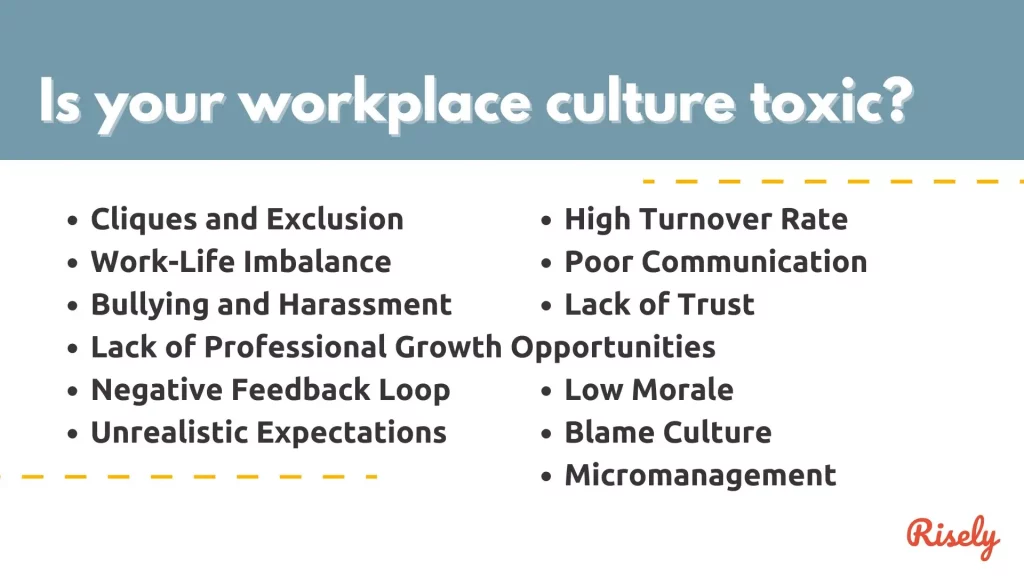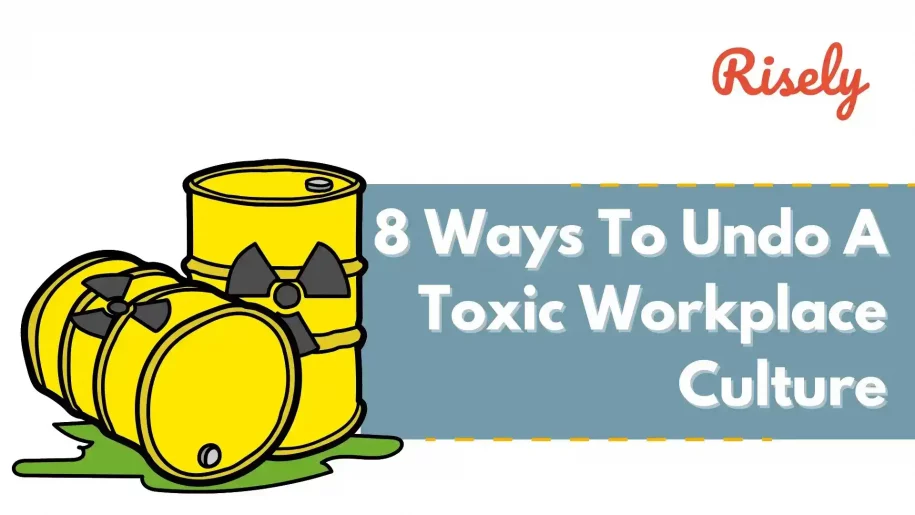8 Ways To Undo A Toxic Workplace Culture
As per Gallup’s research in Australia, mental health conditions contributed to 9% of all work-related injuries. In another global study, almost one in every four workers was found to have experienced some form of violence or harassment at work. In the words of the researchers, these workplace experiences are born out of psychosocial hazards, which harm mental health and notions of employee safety. Navigating through a toxic workplace culture can be mentally and emotionally draining. As per one study, it steals close to 32 hours on every serious claim. Recognizing the signs of toxicity is crucial to preserving your well-being and growth. Understanding the impact of toxicity on your professional development is key to making informed decisions. You must arm yourself with effective strategies to thrive in challenging work environments. And that’s precisely what we are going to do in this blog.How Toxic Cultures Affect Employee Well-being?
Constant exposure to toxic workplace cultures can gravely impact employee well-being. Such environments breed stress, anxiety, and a sense of disempowerment among team members, leading to decreased productivity and increased mental health issues. As per the American Psychological Association, toxic workplaces lead to employees feeling unsafe and prompt searches for safer avenues. The lack of psychological safety and high turnover rates further exacerbate the negative impact on individuals. Employees in such settings often experience a decline in both physical and mental health, resulting in a detrimental effect on their overall well-being. Recognizing these signs is crucial in addressing the issue’s root and fostering a healthier work environment around yourself. Read more: How Do Managers Impact Employee Wellness?8 Effective Strategies to Navigate Through a Toxic Workplace Culture
So, what can you do to ensure your team is safe from a toxic workplace culture? Let’s uncover eight steps to de-toxify a workplace below:#1 Identify the Signs of a Toxic Workplace
Feeling constant stress or anxiety, witnessing frequent conflicts, and experiencing a lack of trust among team members are common signs of a toxic workplace. Do you notice these around you? There’s more to it. High turnover rates, office gossip, and a sense of unease may also indicate a toxic work environment. Pay attention to negative behaviors from the leadership team, such as abusive supervision or unethical practices toward specific employees.
#2 Establish Boundaries to Protect Your Mental Health
Charity begins at home, so let’s start with you. Learn how to set boundaries at work. To safeguard your mental well-being in a toxic workplace, setting clear boundaries is crucial. Define limits on work hours, response times to emails, and interactions with toxic colleagues. You must also prioritize self-care activities outside of work to recharge and maintain balance. If your efforts are met with resistance, communicate assertively to uphold boundaries, emphasizing the importance of mental health. Utilize mindfulness techniques to stay grounded amidst workplace challenges. Remember, protecting your mental health is paramount in navigating through a toxic work environment. After that, ensure that your team can emulate these actions.#3 Seek Support from Trusted Colleagues or Mentors
You might feel lonely when you are in a toxic workplace culture. But remember that your mentors and coaches are there for you. As these people have been in your place before, this is where you can expect understanding and wisdom to navigate tricky waters smoothly. In navigating a toxic work environment, seeking support from trusted colleagues or mentors can provide you with vital guidance and emotional sustenance. Now the question is, how can you do this?- First, connect with individuals who understand the dynamics of your workplace. They can offer valuable insights and a sense of camaraderie. Their outside viewpoint can help you make more informed decisions and build resilience to cope with the toxicity. Embracing this support network can be a lifeline in maintaining your well-being amidst workplace adversity.
- Second, search for coaches and mentors within the organization who know you well. With their understanding of the context, they can give you better, tailored advice on handling a toxic workplace culture.
- Third, step up and be the source of support for your team members. Your team is also reeling under the impact of the same toxic workplace culture. Ensure they know you are with them by opening, communicating, safeguarding, and enabling growth.
#4 Document Instances of Toxic Behavior
In a toxic work environment, documenting instances of toxic behavior is crucial for safeguarding yourself. When you record negative conduct, such as harassment or bullying, you create a factual basis if escalations are needed. Documenting toxic behavior can also help you in discussions with HR or management by providing specific examples. This practice serves to protect your well-being and ensures that there is a clear account of any inappropriate actions. Remember, thorough documentation is a proactive step towards addressing toxicity and fostering a healthier work environment. Can I report toxic behavior to my manager? Absolutely! Ultimately, if efforts at a personal effect fail, schedule a meeting with your manager or supervisor to discuss your concerns, emphasizing your commitment to finding a solution and improving the work environment with positivity. During the meeting, focus on the impact of the toxic culture on your productivity, well-being, and the team’s overall success. Offer suggestions for positive changes and improvements, and be open to feedback or potential solutions from management.Other Interesting Reads
#5 Develop a Personal Wellness Plan
A toxic workplace culture drains energy and soul. But we need to think of something to protect it. Prioritize self-care by developing a personal wellness plan tailored to combat the challenges of a toxic workplace culture. You can incorporate activities promoting mental and physical well-being, such as mindfulness and regular exercise. Moreover, allocate time for activities outside of work to unwind and recharge. Don’t shy away from seeking professional help if needed to address any mental health issues exacerbated by the toxic environment. Utilize resources like Employee Assistance Programs or therapy sessions to navigate this challenging work environment.#6 Explore External Networks and Communities for Support
Tapping into external networks and communities can provide invaluable support when you are navigating a toxic work culture. For instance, you can connect with professionals outside your company to get fresh perspectives and guidance on handling challenging situations. Engaging with like-minded individuals facing similar difficulties can foster a sense of solidarity and provide emotional backing. Online forums, industry events, or networking groups are safe spaces to share experiences and seek advice without fearing judgment. Leveraging external support networks can empower you with the tools and resources needed to navigate through the complexities of a toxic workplace culture.#7 Sharpen your tongue
Effective communication skills are essential for resolving conflicts in a toxic workplace culture. Active listening, empathy, and clear and assertive communication are key elements of effective communication. These skills help you express your concerns, understand different perspectives, and work towards finding solutions. By focusing on your communication skills, you will promote open dialogue, reduce misunderstandings, and contribute to a more positive and collaborative work environment. What about the tough ones? Effective communication techniques can help improve relationships and resolve conflicts when dealing with difficult colleagues in toxic workplace culture. Think of it in five simple steps:- Start by actively listening to the other person’s perspective, showing empathy, and avoiding defensive or confrontational responses.
- Use “I” statements to express your concerns and feelings, focusing on the impact of their behavior on your work and well-being.
- Provide constructive feedback by highlighting specific behaviors and offering suggestions for improvement.
- Seek common ground and find areas of agreement to build rapport and foster a more collaborative working relationship.
- Remember to remain calm and professional in your communication, even if the other person becomes defensive or hostile.
#8 Consider a Strategic Exit if Necessary
Considering a strategic exit is a viable option if all measures to alleviate the toxic workplace culture prove futile. Exiting a toxic work environment safeguards your mental health and overall well-being. It’s crucial to prioritize your health over the job if the situation does not improve. Taking this step can be liberating and lead to better opportunities in healthier work environments. Remember, your well-being is paramount, and leaving a toxic workplace may open doors to a more positive and fulfilling career path.Conclusion
Navigating a toxic workplace culture can be challenging but not impossible. By identifying the signs, setting boundaries, seeking support, and documenting instances of toxicity, you can protect your mental health and well-being along with that of your team. Understanding the impact of a toxic workplace is essential for your professional growth and overall happiness. Stay positive, prioritize your mental health, and take action toward a healthier work environment.Struggling with a toxic workspace?
Talk to Merlin about your situation and get advice curated to your challenges.
Other Related Blogs
What’s Culture Add and Culture Fit? | Victor Bullara
What’s Culture Add and Culture Fit? | Victor Bullara Do we hire for culture, or not? This has been a long raging debate. We create our take on this dialogue…
How To Use A Learning And Development Maturity Model?
How To Use A Learning And Development Maturity Model? How strong is your organization on the learning and development front? Answering that question is not super simple. Many factors are…
Culture Add Vs Culture Fit: Which One Is Good For You
Culture Add Vs Culture Fit: Which One Is Good For You When it comes to recruitment strategies, two terms that often arise are Culture Fit and Culture Add. These concepts…
How Can You Build A High Performing Culture? 7 Hacks
How Can You Build A High Performing Culture? 7 Hacks We have all heard of dream teams and tried to build them with varying levels of success and failure. Among…


